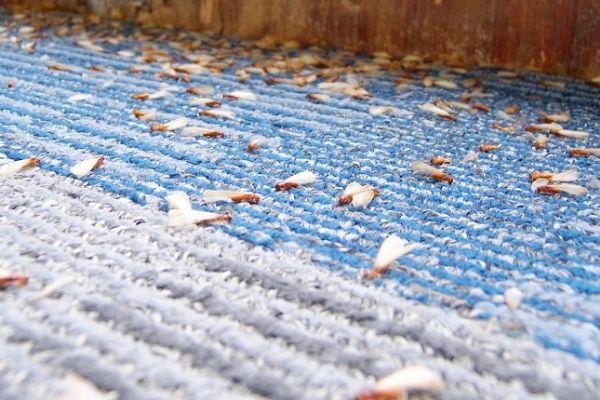Termites in Australia can be the bane and even downfall of many different buildings, whether residential, industrial or commercial. But flying termites in Australia are even worse. That is right, if you were not already aware, termites can come with wings. When you consider what that means for the stability and safety of your property, this is not good news. There are some things you can do to prevent them, and some experts to call when you need to remove them. Here is more information on flying termites.
How to recognise swarmers or flying termites
Keeping swarmers or flying termites away means knowing what they look like. When you look at their body is all one part and is thick and light gold in colour. Their 2 antennae have a small curve in them and then they have 6 legs. Their wings are translucent, they have two wings on each side of the body and they can be up to 3 cm long with a vein-like appearance.
Where can they be found?
These insects do not have one location where they prefer, they can move across the country. They do prefer humid climates and temperatures of 25 to 28 degrees Celsius. When it is warm and raining they will look for breeding grounds when you might find flying termites in your house. In a swarm, there could be as many as 50,000 termites landing together on your property. About 10% of them can reproduce but that is still a large number and a big risk to your home or workplace.
Knowing the difference between flying termites and flying ants
How can you differentiate a flying ant and a flying termite? Both are pests and the wings make them both harder to deal with. In appearance, they are quite similar but ant has 2 big wings at the front part of what is a 3 section body. Their antennae are more bent at an angle rather than the termite’s slight curve. The termites are larger by a couple of millimetres and ants are darker in colour than termites flying around.
If you are there with flying termites in your house
As with a lot of flying insects they are drawn to your lights. If you have lights on and a lot of entry points leading in they could easily swarm towards the light and get in. If you are there when they get in before they ‘settle in’ rather than rushing for a bottle of insect repellent you should try opening up windows and doors and then shutting off the lights. They will then try to find their way out.
Removing them and finding flying termites protection
Part of staying on top of them is to create a schedule where you go round the property looking for signs of termites and do this every two or three months. You could also use this opportunity to look for signs of other pests too, and to just look at the building for general signs of maintenance and repair work. You could put up a protective barrier and a monitoring system so if you are unsure about that, talk to some experts that can help. Professional services are going to be key in finding and removing them. Since they can lay more than thirty thousand eggs a day that colony can become a huge problem in as little as a couple of weeks. This means you need to act quickly. More specific things you can do include;
- Make sure you do not have a lot of damp areas in and around the property. Fix leaks, make sure the basement is not damp. If you make the environment less attractive to them, they might not settle in!
- At all your entrances, windows as well as doors, have security screens or meshes up so that even when these things are left open, the termites cannot get in.
- Another good thing to do for flying termites protection is to avoid storing things like mulch or wood inside as that is somewhere they would be drawn to.
- Keep your house and even your basement free from clutter so there are fewer hiding spots.
But on top of all that it makes a lot of sense to invest in a professional pest control service with experience in handling termites flying on your property. They can also offer you termite control solutions and more advice on what you can do to keep them out.

